Standards Worldwide
Standards Worldwide
Phone +49 30 58885700-07

Standard [CURRENT]
ASTM D 8447:2022
Standard Test Method for Determination of Turbo Charger Deposits by Thermo-Oxidation Engine Oil Simulation Test
- Publication date
- 2022
- Original language
- English
- Pages
- 6
- Publication date
- 2022
- Original language
- English
- Pages
- 6
- DOI
- https://dx.doi.org/10.1520/D8447-22E01
Product information on this site:
Quick delivery via download or delivery service
Buy securely with a credit card or pay upon receipt of invoice
All transactions are encrypted
Short description
1.1 This test method covers the procedure to determine the amount of deposits formed by automotive engine oils utilizing the thermo-oxidation engine oil simulation test (TEOST 2 ). 3 The range and applicability of the TEOST Turbo 2 test method as derived from an interlaboratory study is approximately 5 mg to 9 mg. However, experience indicates that deposit levels of up to 150 mg or greater can be obtained. 1.2 This test method uses a patented instrument, method and patented, numbered, and registered depositor rods traceable to the manufacturer 4 and made specifically for the practice and precision of the test method. 1.3 The values stated in SI units are to be regarded as standard. No other units of measurement are included in this standard. 1.3.1 Milligrams (mg), grams (g), milliliters (mL), and liters (L) are the units provided because they are an industry accepted standard. 1.4 This standard does not purport to address all of the safety concerns, if any, associated with its use. It is the responsibility of the user of this standard to establish appropriate safety, health, and environmental practices and determine the applicability of regulatory limitations prior to use. 1.5 This international standard was developed in accordance with internationally recognized principles on standardization established in the Decision on Principles for the Development of International Standards, Guides and Recommendations issued by the World Trade Organization Technical Barriers to Trade (TBT) Committee.
ICS
43.060.01
DOI
https://dx.doi.org/10.1520/D8447-22E01
Also available in
Loading recommended items...
Loading recommended items...
Loading recommended items...
